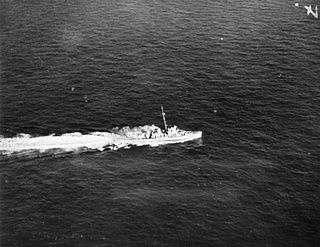HMS Hargood (K582) was a Captain-class frigate which served in the Royal Navy during World War II. Laid down as a Buckley class destroyer escort originally intended for the United States Navy, she was transferred to the United Kingdom under the terms of Lend-Lease before she was finished in 1944, serving in the Royal Navy from 1944 to 1946. She was returned to the U.S. Navy in 1946 and sold for scrapping in 1947.
HMS Holmes (K581) was a Royal Navy Captain-class frigate, originally a Buckley-class destroyer escort intended for the United States Navy. Before she was finished in 1944, she was transferred to the Royal Navy under the terms of Lend-Lease, and was in commission from 1944 to 1945, seeing service during World War II.
The second HMS Narborough (K578) was a British Captain-class frigate of the Royal Navy in commission during World War II. Originally constructed as a United States Navy Buckley class destroyer escort, she served in the Royal Navy from 1944 to 1946.

HMS Retalick (K555) was a British Captain-class frigate of the Royal Navy in commission during World War II. Originally constructed as a United States Navy Buckley class destroyer escort, she served in the Royal Navy from 1943 to 1945.

HMS Riou (K557) was a British Captain-class frigate of the Royal Navy in commission during World War II. Originally constructed as a United States Navy Buckley class destroyer escort, she served in the Royal Navy from 1943 to 1945.
HMS Rowley was a British Captain-class frigate of the Royal Navy in commission during World War II. Originally constructed as a United States Navy Buckley class destroyer escort, she served in the Royal Navy from 1943 to 1945.
The fourth HMS Rupert (K561) was a British Captain-class frigate of the Royal Navy in commission during World War II. Originally constructed as a United States Navy Buckley class destroyer escort, she served in the Royal Navy from 1943 to 1946.
The second HMS Seymour (K563) was a British Captain-class frigate of the Royal Navy in commission during World War II. Originally constructed as a United States Navy Buckley class destroyer escort, she served in the Royal Navy from 1943 to 1946.

HMS Stockham (K562) was a British Captain-class frigate of the Royal Navy in commission during World War II. Originally constructed as a United States Navy Buckley class destroyer escort, she served in the Royal Navy from 1943 to 1946.

The fourth HMS Torrington (K577) was a British Captain-class frigate of the Royal Navy in commission during World War II. Originally constructed as a United States Navy Buckley class destroyer escort, she served in the Royal Navy from 1944 to 1946.
HMS Tyler (K576) was a British Captain-class frigate of the Royal Navy in commission during World War II. Originally constructed as a United States Navy Buckley-class destroyer escort, she served in the Royal Navy from 1944 to 1945.
The second HMS Waldegrave (K579), and the first to enter service, was a British Captain-class frigate of the Royal Navy in commission during World War II. Originally constructed as a United States Navy Buckley class destroyer escort, she served in the Royal Navy from 1944 to 1945.
HMS Cooke (K471) was a British Captain-class frigate of the Royal Navy in commission during World War II. Originally constructed as the United States Navy Evarts-class destroyer escort USS Dempsey (DE-267), she served in the Royal Navy from 1943 to 1946.
HMS Domett (K473) was a British Captain-class frigate of the Royal Navy in commission during World War II. Originally constructed as the United States Navy Evarts-class destroyer escort USS Eisner (DE-269), she served in the Royal Navy from 1943 to 1946.
HMS Gardiner (K478) was a British Captain-class frigate of the Royal Navy in commission during World War II. Originally constructed as the United States Navy Evarts-class destroyer escort USS O'Toole (DE-274), she served in the Royal Navy from 1943 to 1946.

HMS Grindall (K477) was a British Captain-class frigate of the Royal Navy in commission during World War II. Originally constructed as the United States Navy Evarts-class destroyer escort USS Sanders (DE-273), she served in the Royal Navy from 1943 to 1945 and then in the U.S. Navy as USS Grindall (DE-273) from August to October 1945.
HMS Lawson (K516) was a British Captain-class frigate of the Royal Navy in commission during World War II. Originally constructed as the United States Navy Evarts-class destroyer escort DE-518, she served in the Royal Navy from 1943 to 1946.
The second HMS Manners (K568) was a British Captain-class frigate of the Royal Navy in commission during World War II. Originally constructed as the United States Navy Evarts-class destroyer escort DE-523, she served in the Royal Navy from 1943 to 1945.

The second HMS Moorsom (K567) was a British Captain-class frigate of the Royal Navy in commission during World War II. Originally constructed as the United States Navy Evarts-class destroyer escort DE-522, she served in the Royal Navy from 1943 to 1945.

The second HMS Mounsey (K569) was a British Captain-class frigate of the Royal Navy in commission during World War II. Originally constructed as the United States Navy Evarts-class destroyer escort DE-524, she served in the Royal Navy from 1943 to 1946.






